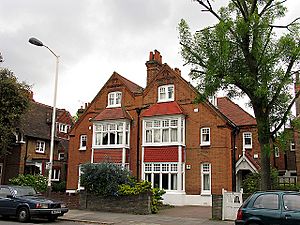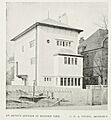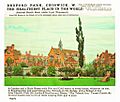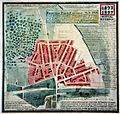Bedford Park, London facts for kids
Quick facts for kids Bedford Park |
|
|---|---|
 Housing on Bedford Road |
|
| OS grid reference | TQ207793 |
| London borough | |
| Ceremonial county | Greater London |
| Region | |
| Country | England |
| Sovereign state | United Kingdom |
| Post town | LONDON |
| Postcode district | W4 |
| Dialling code | 020 |
| Police | Metropolitan |
| Fire | London |
| Ambulance | London |
| EU Parliament | London |
| London Assembly |
|
Bedford Park is a special neighborhood in West London, England. It's known as a "conservation area," which means its unique look and history are protected. Most of Bedford Park is in the London Borough of Ealing, with a small part in the London Borough of Hounslow. You can easily get there by tube at Turnham Green or by London bus routes 94 and E3.
Contents
History of Bedford Park
Bedford Park is famous for being the world's first "garden suburb." This means it was one of the first planned communities that blended houses with green spaces. It became a model for many other neighborhoods around the world.
A German writer named Herman Muthesius said in 1904 that Bedford Park was the "starting point of the smaller modern house." This shows how important its design was.
How Bedford Park Started
The idea for Bedford Park came from a developer named Jonathan Carr. In 1875, he bought about 24 acres (10 hectares) of land in West London. This land was perfect because it was only 30 minutes from the City of London by train. It also had many beautiful old trees. Carr wanted to keep these trees, which helped create the neighborhood's unique, natural layout.
The first architect was Edward William Godwin, but he and Carr didn't agree on plans. Later, Carr hired Richard Norman Shaw, a very famous architect. Shaw designed houses in the "Queen Anne style." These houses looked different from each other but were actually based on a few simple designs. This made the neighborhood look varied and charming.
Life in Bedford Park
In the 1880s, living in Bedford Park was very fashionable. It had its own church, a community hall, shops, a pub, and an art school. Many famous people lived there, including the poet W. B. Yeats and the painter Camille Pissarro. Bedford Park even appeared in books, like G. K. Chesterton’s The Man Who Was Thursday. People even wrote a funny poem about it called the "Ballad of Bedford Park."
Over time, Bedford Park became less trendy. Some houses were split into smaller apartments. Bus drivers even joked and called it "Poverty Park." In 1963, a building called The Bramptons was torn down to build a new old people's home. This made people worried about the future of Bedford Park.
This worry led to the creation of the Bedford Park Society in 1963. Thanks to their efforts, in 1967, many houses (356 of them) were officially protected. A few years later, both the Ealing and Hounslow councils made Bedford Park a "conservation area." Since then, the neighborhood has improved. Many houses have been restored and are now family homes again.
The Bedford Park Society
| Motto | For the protection of the amenities of the earliest Garden Suburb |
|---|---|
| Formation | 1963 |
| Legal status | registered charity |
|
Chairman
|
Helen Jameson |
|
Main organ
|
The Bedford Park Society Newsletter |
The Bedford Park Society is a group that works to protect this special neighborhood. It was started in 1963 by two local people, Harry Taylor and Tom Greeves. They were worried when an old building was demolished to make way for a new one. John Betjeman, a famous writer, became their first supporter.
In its first year, the society grew to 200 members. They encouraged people not to make big changes to their homes that would spoil the area's look. Tom Greeves knew that the best way to protect the neighborhood was to get the buildings officially "listed." This means they would be recognized as important historical buildings.
In 1967, their hard work paid off. An exhibition about Bedford Park's art and architecture helped. A government inspector visited, and soon after, 356 houses in Bedford Park were given "Grade II listed" status. This means they are protected by law. Then, the local councils in Ealing (1969) and Hounslow (1970) declared their parts of Bedford Park "conservation areas." Tom Greeves, who led the society for many years, passed away in 1997.
The society has stopped many plans to demolish buildings. They have also helped keep the architectural quality of the area high. They give a "Log Book" to owners of listed houses. This book helps owners learn about their home's history and how to take care of it. The society also checks all building plans and shares its opinions with the local councils.
The main goal of the society is to keep Bedford Park a beautiful and pleasant place to live. They also get involved in other issues like parking and traffic if they affect the environment of the area.
Conservation Area Rules
The Bedford Park conservation area covers a wide space. It stretches from Esmond Road in the west to Abinger Road in the east, and from Flanders Road in the south to Fielding Road in the north.
If you live in a conservation area, you need special permission for most new building work, changes, or additions to your home. This includes things like adding new windows or putting up satellite dishes.
Listed Buildings
Many of the older buildings in Bedford Park are "Grade II listed." This means the entire building is protected. This includes the inside, any small buildings outside, and even the walls and fences around the property. You need special permission for any changes, additions, digging, or demolition work on a listed building.
Protecting Trees
All trees in the conservation area are protected. It is against the rules to cut or work on a tree without written permission from the local council.
Planning Committee Role
The Bedford Park Society is asked by the local councils to look at all plans for new buildings or changes. The councils consider the society's opinions when they decide whether to approve these plans. Ealing also has a special committee that gives advice on conservation area plans.
Images for kids
-
Bedford Park's church of St Michael and All Angels
-
Leafy artists' suburb: a tile-hung detached house on Rupert Road, Bedford Park, by the architect Norman Shaw, 1879
-
'Bedford Park, Chiswick, W. the Healthiest Place in the World': coloured lithograph by Frederick Hamilton Jackson, c. 1882
-
The Church, Tabard Inn and Stores from Acton Green by Edward Hargitt, 1882
-
The estate club on The Avenue by Norman Shaw, 1878
-
Shaw's 1878 plans for Bedford Park Club, with two billiard rooms
-
Joseph Nash Jr.'s studio with 1879 cartouche, Blenheim Road, on Norman Shaw corner house
-
Bath Road by the Impressionist Camille Pissarro, 1897
See also
 In Spanish: Bedford Park, Londres para niños
In Spanish: Bedford Park, Londres para niños

































